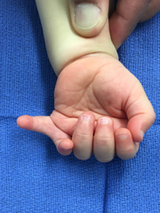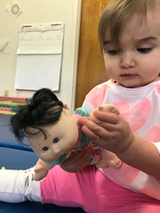Postaxial polydactyly (extra pinky finger): Kaylee’s story
Postaxial polydactyly (extra pinky finger): Kaylee’s story
Kaylee is a bright-eyed, sociable and determined toddler. She loves music, dancing and playing with her baby dolls. A small scar is the only trace of the extra finger she was born with on her left hand.

Kathryn and Brian first found out about their daughter’s extra pinky finger at a routine 20-week ultrasound. The technician asked the expectant parents if either of them had a history of upper limb abnormalities or extra digits in their families, which they didn’t. “I think my first reaction was confusion. I had never heard of polydactyly and that was probably the last thing I expected to hear,” Kathryn remembers.
Genetic testing on the baby had already come back normal, and additional tests over the next few weeks ruled out any other medical issues. The extra finger was an isolated issue. It wasn’t a serious threat to their child’s health and it could be more accurately diagnosed and dealt with after birth.
Kaylee was born in January 2016 at a New York City hospital, a healthy baby, but with a fully formed extra pinky finger emerging at a right angle to her other fingers. A surgeon examined her and determined that the finger originated in the palm of her hand, along with the other fingers. It was likely the result of a split in the pinky finger early in development. He explained that it could be surgically removed when their daughter was a little older.
Consultation with a pediatric surgeon

That spring, Kaylee’s pediatrician referred them to Apurva S. Shah, MD, a hand and upper limb surgeon at Children's Hospital of Philadelphia (CHOP) who specializes in pediatric orthopedic surgery.
Dr. Shah is an attending physician with CHOP’s Hand and Arm Disorders Program, which cares for children with a diverse set of hand and upper limb conditions, including congenital hand differences like Kaylee’s. Each year, this team of orthopedic and plastic surgeons perform more than 1,000 procedures on children with conditions affecting their hands or arms.
The family made an appointment and met with Dr. Shah in the summer of 2016, when Kaylee was 7 months old. “From the moment we walked in, we found the facilities and staff at CHOP to be so welcoming,” Kathryn says. “They definitely catered to children and families. Our visit was well-organized, efficient and informative. Dr. Shah was very patient and took the time to answer all of our questions. We knew at that first meeting that he was the right doctor to perform Kaylee’s surgery.”
X-rays of Kaylee’s hand were taken during that initial visit, and Dr. Shah reviewed them with the parents. He explained that the surgery would be a bit more involved than simply removing the extra finger. The remaining finger would need to be reconstructed as part of the procedure. Specifically, some of the muscles, tendons and ligaments from the extra pinky finger would be salvaged and repurposed to maximize function in the remaining pinky finger. He recommended that the procedure be done after Kaylee turned 1 year old, when her hand was more fully developed, but before the extra digit began to interfere with daily life.
The parents agreed, and surgery was scheduled for the following January, just after Kaylee’s first birthday.
Successful surgery
The surgery went well. Kaylee’s parents were kept informed of progress through regular updates in the waiting room, then received a full report from Dr. Shah when it was completed. “Dr. Shah explained exactly what he had done, spent time with us to address our questions and outlined the next steps in Kaylee’s recovery,” says Kathryn. “We left the hospital knowing exactly what to do next and what to expect from Kaylee in the days, weeks and months ahead.”
Dr. Shah had removed the extra digit, but used some of the muscles, tendons, and ligaments from the extra finger it to strengthen the remaining pinky finger. He had inserted a temporary metal pin in the finger to stabilize it, and had put Kaylee’s arm in a bright pink cast. She was discharged that day. Dr. Shah anticipated that Kaylee would be comfortable and would not need much pain medicine after surgery.
“By the next day she was ready to take off crawling,” says Kathryn. She was walking five weeks later when she had the pin and cast removed. Occupational (hand) therapy over the next few weeks helped speed the recovery of strength and flexibility in her arm and hand. She did exercises to bend and straighten her fingers. She was encouraged to crawl to rebuild strength in her arm and hand. And she was given toys that required two hands to manipulate. Two months after the cast was removed, her mobility, dexterity and strength were all back.
Because their home is a two-hour drive from Philadelphia, the family shared information on Kaylee’s progress with Dr. Shah in emails with photos and videos. Dr. Shah offers this alternative to families that travel to CHOP from out of the state or country. This communication was facilitated by Nurse Navigator Maribeth Magarity, who is available to assist out-of-town families that live far from Philadelphia. Kaylee and her parents return to see Dr. Shah for a one-year follow-up visit, but he doesn’t expect she’ll need any further treatment.
Kaylee today

Now a 10-fingered 1-year-old, Kaylee is full of life. She enjoys being the center of attention, and loves to give big hugs. Kathryn describes her as “a goofy, affectionate and strong-willed little girl. She knows what she wants.” She loves music and dance, and enjoys playing outside and going to the library. “We are so grateful to Dr. Shah and everyone at CHOP,” says Kathryn. “Looking back on our experience with Kaylee’s treatment, it was seamless from beginning to end. We felt supported and were kept well-informed before and during Kaylee’s surgery. The nurses, doctors and staff at CHOP truly treated us as if we were family. As new parents going through a new medical experience, we couldn’t have asked for a more positive experience.”